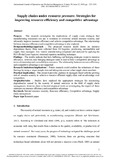- CERES Home
- →
- School of Management (SoM)
- →
- Staff publications (SoM)
- →
- View Item
JavaScript is disabled for your browser. Some features of this site may not work without it.
| dc.contributor.author | Kalaitzi, Dimitra | |
| dc.contributor.author | Matopoulos, Aristides | |
| dc.contributor.author | Bourlakis, Michael | |
| dc.contributor.author | Tate, Wendy | |
| dc.date.accessioned | 2019-12-09T10:46:37Z | |
| dc.date.available | 2019-12-09T10:46:37Z | |
| dc.date.issued | 2019-12-10 | |
| dc.identifier.citation | Kalaitzi D, Matopoulos A, Bourlakis M, Tate W. (2019) Supply chains under resource pressure: strategies for improving resource efficiency and competitive advantage. International Journal of Operations and Production Management, Volume 39, Issue 12, November 2019, pp. 1323-1354 | en_UK |
| dc.identifier.issn | 0144-3577 | |
| dc.identifier.uri | https://doi.org/10.1108/IJOPM-02-2019-0137 | |
| dc.identifier.uri | http://dspace.lib.cranfield.ac.uk/handle/1826/14808 | |
| dc.description.abstract | Purpose – The purpose of this paper is to investigate the implications of supply chain strategies that manufacturing companies can use to minimise or overcome natural resource scarcity, and ultimately improve resource efficiency and achieve competitive advantage. The relationship between resource efficiency and competitive advantage is also explored. Design/methodology/approach – The proposed research model draws on resource dependence theory. Data were collected from 183 logistics, purchasing, sustainability and supply chain managers from various manufacturing companies and analysed by applying the partial least squares structural equation modelling technique. Findings – The results indicate that both buffering and bridging strategies improve resource efficiency; however, only bridging strategies seem to lead to firm’s competitive advantage in terms of ownership and accessibility to resources. The relationship between resource efficiency and competitive advantage is not supported. Research limitations/implications – Future research could confirm the robustness of these findings by using a larger sample size and taking into account other supply chain members. Practical implications – This research provides guidance to managers faced with the growing risk of resource scarcity to achieve a resource efficient supply chain and an advantage over competitors. Originality/value – Studies have explored the appropriate strategies for minimising dependencies caused by the scarcity of natural resources in the field of supply chain management; however, there is limited empirical work on investigating the impact of these strategies on resource efficiency and competitive advantage. Purpose – The purpose of this paper is to investigate the implications of supply chain strategies that manufacturing companies can use to minimise or overcome natural resource scarcity, and ultimately improve resource efficiency and achieve competitive advantage. The relationship between resource efficiency and competitive advantage is also explored. Design/methodology/approach – The proposed research model draws on resource dependence theory. Data were collected from 183 logistics, purchasing, sustainability and supply chain managers from various manufacturing companies and analysed by applying the partial least squares structural equation modelling technique. Findings – The results indicate that both buffering and bridging strategies improve resource efficiency; however, only bridging strategies seem to lead to firm’s competitive advantage in terms of ownership and accessibility to resources. The relationship between resource efficiency and competitive advantage is not supported. Research limitations/implications – Future research could confirm the robustness of these findings by using a larger sample size and taking into account other supply chain members. Practical implications – This research provides guidance to managers faced with the growing risk of resource scarcity to achieve a resource efficient supply chain and an advantage over competitors. Originality/value – Studies have explored the appropriate strategies for minimising dependencies caused by the scarcity of natural resources in the field of supply chain management; however, there is limited empirical work on investigating the impact of these strategies on resource efficiency and competitive advantage. | en_UK |
| dc.language.iso | en | en_UK |
| dc.publisher | Emerald | en_UK |
| dc.rights | Attribution-NonCommercial 4.0 International | * |
| dc.rights.uri | http://creativecommons.org/licenses/by-nc/4.0/ | * |
| dc.subject | Supply chain management | en_UK |
| dc.subject | Competitive advantage | en_UK |
| dc.subject | Resource efficiency | en_UK |
| dc.subject | Natural resource scarcity | en_UK |
| dc.title | Supply chains under resource pressure: strategies for improving resource efficiency and competitive advantage | en_UK |
| dc.type | Article | en_UK |
| dc.identifier.cris | 25478289 |
Files in this item
The following license files are associated with this item:
This item appears in the following Collection(s)
-
Staff publications (SoM) [1258]

